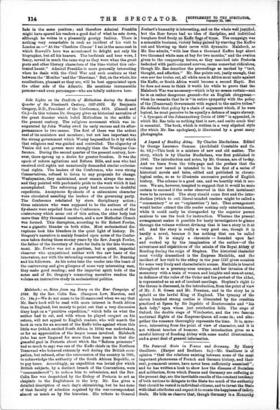A Legend of Beading Abbey. By Charles Macfarlane. Edited by
George Laurence Gomme. (Archibald Constable and Co. 3s. 61)—This book is a mixture of new and old matter. The story, which is by Charles Macfarlane, was first published in 1846. The introduction and notes, by Mr. Gomme, are of to-day. And we learn from the title-page and the preface that the volume now issued is intended to be the first of a series of historical novels and tales, edited and published in chrono- logical order, so as to illustrate successive periods of English history. The scheme is a good one, and we heartily wish it suc- cess. We are, however, tempted to suggest that it would be more certain to succeed if the order observed in this first instalment were to be reversed. The story should come first and the intro- duction (which to suit literal-minded readers might be called a " commentary " or an "explanation ") last. That arrangement would better attract the idle reader seeking only entertainment, while it could easily be disregarded by the superior person anxious to use the book for instruction. Whereas the present arrangement makes it possible for hasty investigators to glance through the volume without divining that it has a story in it it all. And the story is really a very good one, though it is hardly a novel, because it has nothing that can be called a plot. It is simply a chronicle — founded upon fact and worked up by the imagination of the author—of the adventureS and eipariences a the mbnks of the Royal Abbey of Reading during the reign of Stephen. The historical character most vividly dramatised is the Empress Mathilda, and the incident of her visit to the abbey in the year 1137 gives occasion for some very lively and characteristic scenes. Matlailda is treated throughout as a presumptuous usurper, and her invasion of the monastery with a train of women and knights and men-at-armi, in defiance of the rules of the Order and the protest of the abbot, is represented as an act of insolent sacrilege. Stephen's right to the throne is discussed, in the introduction, from the point of view of Mr. J. R. Green and Mr. Freeman, and in the story he is upheld as the lawful King of England. The tyranny of the eleven hundred strong castles is illustrated by the cruelties practised at Speen by Sir Ingelric of Huntercombe and "his dark lady," upon whom just retribution falls. The siege of Oxford, the double siege of Winchester, and the two famous nocturnal flights of the Empress-Queen all come in; and alto - gether the romance thoroughly represents the time. It is, more- over, interesting from the point of view of character, and it is not without touches of humour. The introduction gives us a careful history of Reading Abbey with some useful illustrations, and a great deal of general information.


















































 Previous page
Previous page